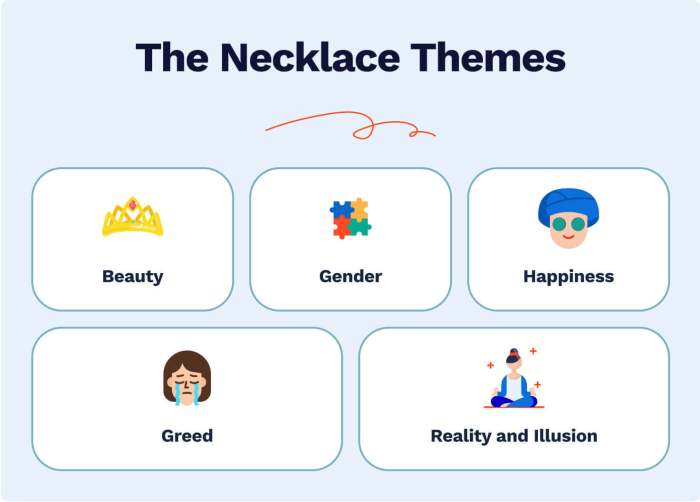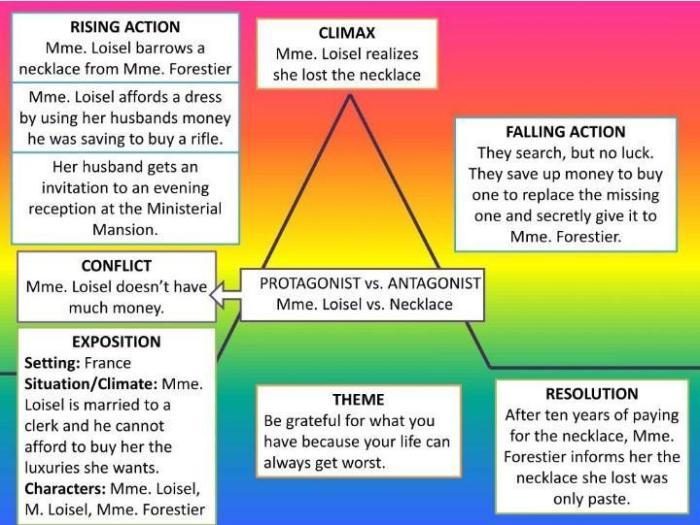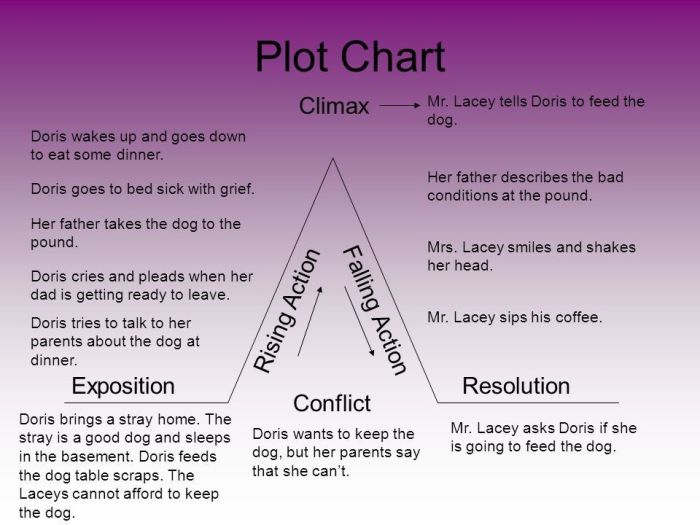Exposition of the story the necklace – Embarking on an exposition of “The Necklace,” we delve into the intricate tapestry of Guy de Maupassant’s masterpiece, where the titular adornment serves as a catalyst for a profound exploration of human desire and its consequences.
Within the vibrant setting of 19th-century Paris, we encounter Mathilde Loisel, a woman consumed by envy and longing, and her pragmatic husband, whose contrasting perspectives ignite the central conflict of the story.
Introduction to “The Necklace”: Exposition Of The Story The Necklace

Guy de Maupassant’s “The Necklace” is a captivating short story that delves into the themes of vanity, desire, and the consequences of one’s choices. Set in 19th-century Paris, the story follows the life of Mathilde Loisel, a young woman consumed by envy and a longing for a life beyond her means.
The necklace, a symbol of wealth and status, plays a pivotal role in the story. It becomes an object of Mathilde’s obsession, driving her to make a series of fateful decisions that ultimately lead to her downfall.
Significance of the Necklace, Exposition of the story the necklace
The necklace represents the unattainable desires and social aspirations that consume Mathilde. Its beauty and value serve as a constant reminder of the life she believes she deserves but cannot have. As Mathilde becomes increasingly fixated on the necklace, she loses sight of her true values and the consequences of her actions.
The loss of the necklace becomes a turning point in Mathilde’s life. It forces her to confront the reality of her situation and the consequences of her vanity. The story serves as a cautionary tale about the dangers of allowing desire to cloud one’s judgment and the importance of contentment with one’s lot in life.
Exposition of the Story

The story “The Necklace” by Guy de Maupassant unfolds in 19th century Paris, during the Belle Époque. This era was characterized by economic prosperity and a focus on material wealth and social status. The setting plays a crucial role in establishing the characters’ lives and motivations, as they navigate the societal expectations and pressures of their time.
Characters
The main characters of the story are Mathilde Loisel and her husband, Monsieur Loisel. Mathilde is a beautiful and ambitious woman who longs for a life of luxury and social acceptance. She is dissatisfied with her modest circumstances and believes she deserves a more glamorous existence.
Monsieur Loisel, on the other hand, is a kind and hardworking clerk who loves Mathilde but lacks the means to fulfill her desires.
Conflict
The central conflict of the story arises from Mathilde’s desire for material wealth and social status. She is invited to a prestigious ball hosted by the Minister of Education, but she does not have a suitable dress. Desperate to make an impression, she borrows an exquisite necklace from her wealthy friend, Madame Forestier.
Expositional Techniques
Maupassant employs several literary techniques to introduce and develop the story’s elements. Foreshadowing is used to hint at the impending disaster that awaits Mathilde. The necklace itself is described as “of great value,” suggesting that its loss will have serious consequences.
Additionally, the story’s setting in Paris, a city known for its fashion and extravagance, foreshadows Mathilde’s obsession with material possessions.
Symbolism is also employed throughout the story. The necklace represents Mathilde’s desire for wealth and social status. Its loss symbolizes the shattering of her dreams and the consequences of her vanity. The story also uses characterization to reveal the characters’ motivations and personalities.
Mathilde’s shallowness and materialistic nature are contrasted with Monsieur Loisel’s kindness and selflessness.
Theme and Symbolism

In “The Necklace,” Maupassant explores the themes of deception, desire, and social class. These themes are developed through the characters and events of the story.
Theme: Deception
The story revolves around the deception of Mathilde Loisel. She pretends to be wealthy and sophisticated, but she is actually poor and insecure. This deception leads to her downfall when she loses the borrowed necklace.
Theme: Desire
Mathilde is driven by her desire for wealth and status. She is willing to do anything to achieve her goals, even if it means lying or stealing. This desire ultimately leads to her destruction.
Theme: Social Class
The story also explores the theme of social class. Mathilde is obsessed with being accepted by the upper class. She believes that if she can acquire the right clothes and jewelry, she will be able to fit in. However, she learns that true acceptance cannot be bought.
Symbolism
Maupassant also uses symbolism in the story to represent deeper meanings or ideas. For example, the necklace is a symbol of Mathilde’s desire for wealth and status. It is also a symbol of her deception, as she pretends to own it.
Symbolism: The Necklace
The necklace is the most important symbol in the story. It represents Mathilde’s desire for wealth and status. It is also a symbol of her deception, as she pretends to own it. The necklace is ultimately lost, which symbolizes Mathilde’s loss of hope and dreams.
Symbolism: The Dress
The dress that Mathilde borrows from her friend is another important symbol. It represents Mathilde’s desire to be accepted by the upper class. She believes that if she can wear the right clothes, she will be able to fit in.
However, she learns that true acceptance cannot be bought.
Style and Language

Maupassant’s writing style in “The Necklace” is characterized by its precision, objectivity, and economy of language. He uses simple, clear sentences and avoids unnecessary ornamentation or digressions. His descriptions are vivid and evocative, creating a strong sense of place and atmosphere.
Literary Devices
Maupassant also employs a range of literary devices to enhance the story’s impact. Imagery, metaphors, and similes are used to create vivid mental pictures and convey the characters’ emotions and experiences.
- Imagery:Maupassant uses vivid imagery to create a strong sense of place and atmosphere. For example, he describes the “gray sky” and “dreary houses” of the Loisels’ apartment, which reflects their poverty and unhappiness.
- Metaphors:Maupassant also uses metaphors to compare two things in a way that creates a vivid image. For example, he describes the necklace as a “symbol of victory, of triumph over all other women.” This metaphor suggests that the necklace is not merely an object but a representation of Mathilde’s desire for social status and admiration.
- Similes:Maupassant also uses similes to compare two things using the words “like” or “as.” For example, he describes Mathilde’s “pale face” as “a white flower.” This simile suggests that Mathilde is both beautiful and fragile.
Language
Maupassant’s use of language in “The Necklace” is also noteworthy. He uses precise and evocative words to create a strong sense of realism and authenticity. His sentences are often short and to the point, which adds to the story’s overall sense of urgency and suspense.
- Word Choice:Maupassant carefully chooses his words to create specific effects. For example, he uses the word “misery” to describe the Loisels’ poverty, which suggests that their financial struggles are not merely a matter of inconvenience but a source of deep emotional pain.
- Sentence Structure:Maupassant also uses sentence structure to create specific effects. For example, he uses short, choppy sentences to convey the Loisels’ sense of desperation after they lose the necklace. These sentences create a sense of urgency and panic, which adds to the story’s overall impact.
FAQ
What is the significance of the necklace in the story?
The necklace serves as a symbol of Mathilde’s aspirations and the unattainable desires that ultimately lead to her downfall.
How does the setting contribute to the story’s conflict?
The disparity between Mathilde’s impoverished background and her aspirations within the materialistic society of 19th-century Paris fuels her discontent and drives the conflict.